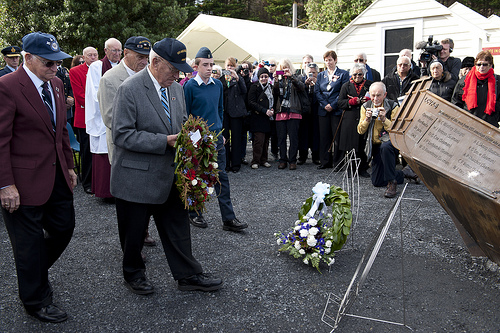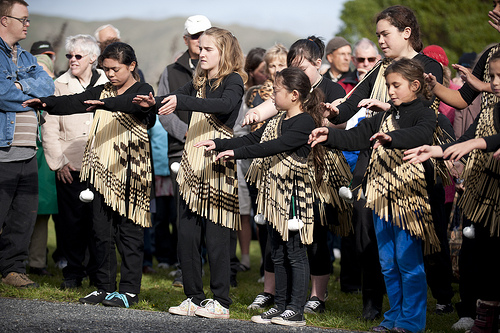I very much regret not being able to get back to Wellington from my Washington meetings in time for Memorial Day this year. I had been looking forward to the annual memorial service at Old St Paul’s and the special events in Paekakariki, but flight schedules did not align favorably.
Several of my colleagues, including my Deputy Chief of Mission Marie Damour, attended today’s events on my behalf. I asked my colleague Adrian Pratt to share his impressions of the memorials. His guest post follows immediately below.
* * *
AP: Today Frank Zalot Jr. came back for the first time to the place he saw 10 of his shipmates drown on a dreadful day in 1943.

Frank Zalot Jr. being interviewed by Adrian Pratt (left) at today's Kapiti US Marines Trust 70th Anniversary Memorial Day Service.
This Memorial Day the people of Kapiti Coast on the North Island of New Zealand unveiled a memorial to the 10 U.S. sailors who died during a training exercise while trying to come ashore on June 20, 1943. About 350 people, including Charge d’Affaires Marie Damour and a U.S. Marine Color guard, were there for the dedication of the memorial, sculptured into the shape of a landing craft, close to the waters where the tragedy occured.
The story of the drowning only recently came to light. At last year’s Memorial Service Kapiti Mayor Jenny Rowland read out the names of the dead for the first time. A world away, in Massachusetts, that reading had a profound effect on Zalot.

The Memorial Day Service pōwhiri lead by Tangata Whenua from Atiawa ki Whakarongotai, Raukawa and Toa Rangatira
“For 68 years I had this nightmare,” the still spritely Zalot said. “I could hear the men screaming.”
After the Memorial Day service last year, Zalot went to sleep, expecting again to hear the screams of his drowning friends. But the nightmare did not return. “I realized it wasn’t their screams I’d been hearing. It was them yelling, ‘tell our story.’ I’ve not heard their screams since.”
Seventy years ago, on June 12, 1942 the first U.S. servicemen began arriving on New Zealand. Most of the Kiwi troops were fighting World War II in Europe and North Africa. The country felt vulnerable to attack after Pearl Harbor. Between 1942 and 1944 more than 150,000 U.S. troops were deployed to New Zealand, to train and then depart for the bloody battles of the Pacific. Close bonds were formed between New Zealanders and their American guests.

LTC Steven Johnson addressing the crowd at the Kapiti Coast Memorial Day Service earlier today.
The weather off the Kapiti Coast on that day in 1943 was fierce, with a cold rain driven in on gale-force winds. Frank Zalot Jr., a U.S. sailor who’d enlisted in the Navy right after the attack on Pearl Harbor, was a long way from his small-town home in Massachusetts on that day, the day “everything went wrong.”
Two other U.S. veterans who were there that day – Ted Picard on the rescue boat and Ray LaPlante aboard the American Legion – were also part of the Memorial Day services in Paekakariki.

Governor-General, Lt Gen The Rt Hon Sir Jerry Mateparae along side U.S. Veterans Ray LaPlante, Ted Picard and Frank Zalot Jr. at today's Memorial Day Service.

Ted Picard, Frank Zalot Jr, and Ray LaPlante at the Memorial Day Service today.
On what would turn out to be a fateful day, about 1,600 U.S. Marines were to be brought to shore on 35 landing craft (LCVP) from the troop transport ship the American Legion, Zalot’s ship. After dropping the Marines about 100 feet offshore into frigid waters being pounded by waves, the 35 LCVPs tried desperately to get back to the ship. But the ferocious conditions along with a falling tide left all of them stranded.
After the other 34 vessels successfully re-launched later that day, the mission scrubbed, it was discovered that the engine on Zalot’s LCVP was dead. They would require a tow, stern-first, back out to the American Legion. The weather had not abated. It was dark now, after 11 p.m., and the breakers were roaring in at eight to 10 feet. Being towed backwards, the boats did not cut through the waves. Rather, they smashed through them violently and were deluged by walls of water. After a merciless pounding one monster wave capsized the boat, still about half a mile from the relative safety of the American Legion. Men in their heavy equipment hit the waters and began immediately to sink.

The large crowd at today's Memorial Day Service.
“I started to pull myself to the surface, grabbing a shipmate’s belt-buckle on the way up,” Zalot has written. “When I broke the surface, there was a scene that became a nightmare. Men were screaming. ‘Help, help! I can’t swim!’ Before this I naively thought that only women and girls screamed, but I quickly learned that men can scream too – scream as they are dying.”
Coming back to New Zealand after all these years has been “overwhelming,” Zalot said. The people of New Zealand have made a fuss over him and the memories from long ago have come back strongly.
Zalot was in the freezing, violent water for a long time that night.

The Memorial to sailors of the USS American Legion.
“It was still pitch dark and the roar of the wind and sea was very loud,” Zalot wrote. “Suddenly the clouds parted and the moon came out. I desperately started looking for a pencil, paper, and a bottle. I knew I was dying and wanted to write a note to my mother to tell her that I was thinking of her right to the very end. Then I passed out. I don’t remember hearing or seeing the rescue boat. One of the sailors in the rescue boat said he saw my hand sticking up from the water and threw a life-ring over it; then he pulled me over to the boat.”

Frank Zalot Jr. laying a wreath in front of the Memorial to sailors of the USS American Legion.
In addition to the terrible images from that night, Zalot carries with him a haunting tale.
He was returned to Wellington, just down the coast from Kapiti, that night. Zalot could see where the war was heading and knew that he and his comrades would soon be shipped closer to the fighting and away from New Zealand. Wellington had been their home base for more than a year and Zalot had been “adopted” by a Kiwi family, the O’Briens. The day after the awful incident that had nearly cost him his life, Zalot told his doctor he was heading into town to say goodbye to his friends.

Zane Te Wiremu Jarvis singing the National Athems of New Zealand and the United States.
Zalot recalls that the doctor told him, “‘If your temperature drops to 105, you can go.’ And I said, if it goes up to 125, I’m still going. He said ‘Go ahead. I won’t stop you.’”
The O’Briens ran a milk bar, a place to socialize and enjoy a milk shake. When he arrived there his Kiwi “mother” asked him if he had heard about the terrible tragedy off Kapiti the night before.

The Paekakariki Primary School Kapa Haka Group at today's Memorial Service.
“Did I hear about it?! I was in it,” Zalot wrote. “Then I told her the story. She didn’t say another word. Two weeks later I received one-page letter from her:
“My Dearest Frank,
On the night of the 20th I was very tired and retired early. I had a dream that you were in terrible danger. I got out of bed, onto my knees and prayed to God to see you safely through your danger. I prayed on my knees for a very long time, at least 45 minutes. It was midnight when I got back into bed. I couldn’t tell you this that night at the milk bar. But I wanted you to know. Your loving New Zealand mother, Jean O’Brien.
“We capsized at 11:17 pm and I was rescued at midnight. (Our watches had stopped at 11:17; they weren’t waterproof.) Did God really hear the prayer of a loving mother whose son was in terrible danger or was this just a coincidence?”

Service people during the playing of TAPS at today's Memorial Service at Paekakariki.
It’s a question Zalot has carried with him for nearly 70 years.
Ten U.S. servicemen drowned off Paekakariki on June 20, 1943; one officer and nine enlisted men:
H.C. Winfrey (Ensign), Howard J. Britton (Seaman 1st Class), Joseph P. Lorbietski (Seaman 1st Class), William D. Roundtree (Seaman 1st Class), Alva L. Skoog (Boatswain’s Mate 1st Class), Kenneth G. Snow (Seaman 1st Class), Alden P. Thatcher* (Seaman 1st Class), Charles F. Vetter (Seaman 1st Class), Walter J. Yanghis (Seaman 1st Class), Cox (first name & rank not available).
And today they were officially remembered. And the screams in Zalot’s head have gone.

The Memorial to sailors of the USS American Legion.
AP
* * *
Thanks to Adrian and especially to Frank for sharing such a compelling story. As we enter the month of June we will be sharing additional historical anecdotes, personal remembrances, and bits of local color from the 1940s as part of our commemoration of the 70th anniversary of the arrival of American forces in Aotearoa after the outbreak of World War II.
Stay tuned for more information about the Embassy’s anniversary events including the concert tour by the U.S. Marine Band, lectures by a Marine historian, ceremonies in Wellington and Auckland, and release of commemorative stamps and a commemorative coin. I will also be sharing photos from our Independence Day receptions which this year will be held in June to coincide with the anniversary dates and will be themed for 1942.

 Tomorrow will be a great day. I am in Apia, and will be participating in celebrations of the 50thanniversary of the former Western Samoa’s independence from foreign rule. I feel a particular connection to the event because New Zealand was Samoa’s former administrator, and I am officially accredited to both nations.
Tomorrow will be a great day. I am in Apia, and will be participating in celebrations of the 50thanniversary of the former Western Samoa’s independence from foreign rule. I feel a particular connection to the event because New Zealand was Samoa’s former administrator, and I am officially accredited to both nations.![]()
 RSS
RSS


















 View my Profile
View my Profile Connect with Wellington
Connect with Wellington Watch our Videos & Subscribe
Watch our Videos & Subscribe Watch our Videos on Vimeo
Watch our Videos on Vimeo Connect on GPlus
Connect on GPlus US Embassy NZ
US Embassy NZ


 Post Entries (RSS)
Post Entries (RSS)

